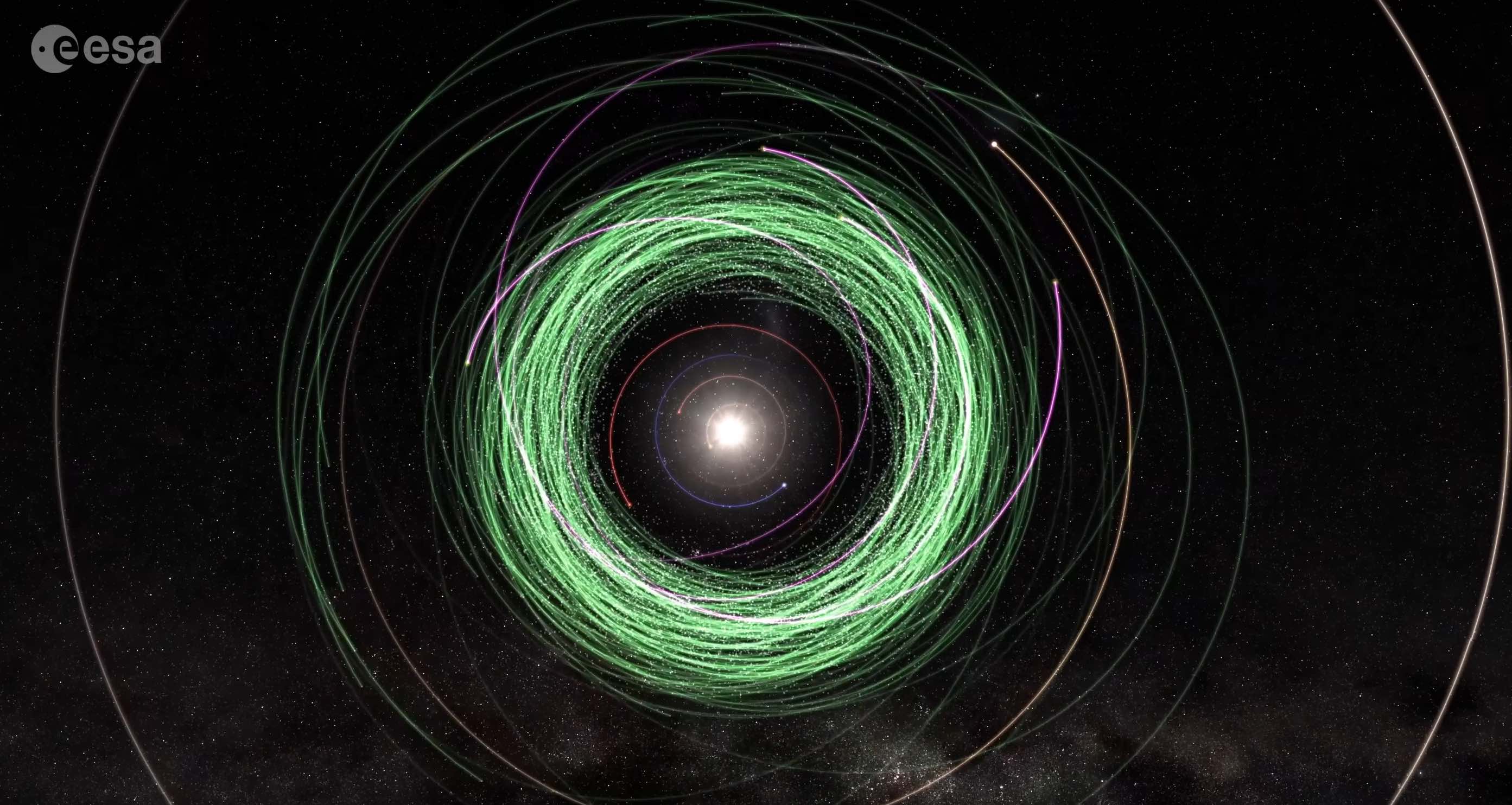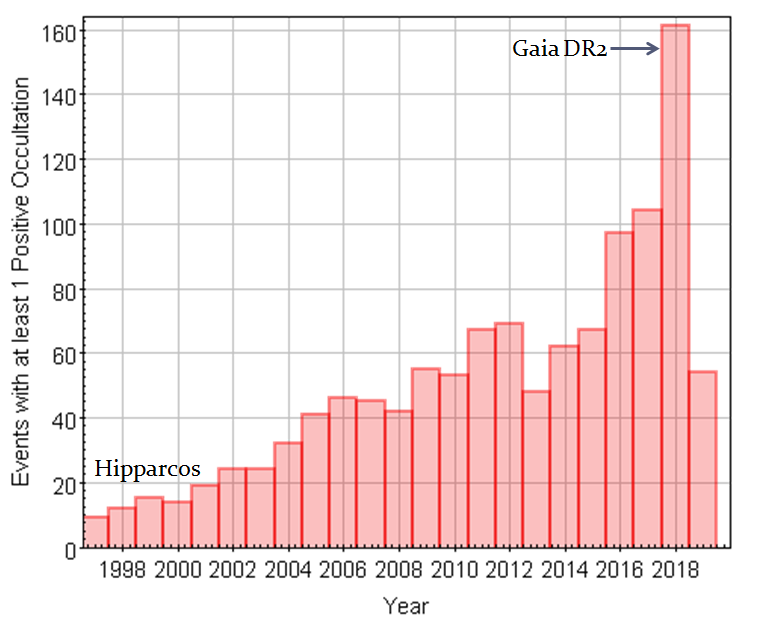IoW_20200630 - Gaia
Image of the Week |
Gaia's impact on Solar system science
|
|
Figure 1: The 14,099 asteroids in Gaia Data Release 2 (indicated with green orbits) along with four newly discovered asteroids by Gaia (indicated with the pink orbits). Credits: ESA/Gaia/DPAC. Acknowledgements: Created with Gaia Sky by S. Jordan and T. Sagrista using info from Gaia DPAC CU4 / F. Spoto. |
|
Gaia's impact on Solar System science follows not only from its observations of Solar System objects themselves, but also from the improved knowledge of the position and motion of stars. Asteroids are observed against a background of stars. These stars will thus appear in the images taken of asteroids, and are used as reference points to determine where asteroids are in space. The knowledge of where a background star is at the respective moment in time is therefore essential. With the advent of the accurate positions and proper motions of stars in the Gaia data releases, astronomers have started to recompute the asteroid's positions based on old asteroid observations. These more precise asteroid positions have in turn lead to the computation of more precise orbits. Going back in time, one can see if there are older observations that match with a given asteroid or, when going forward in time, predict where asteroids will be in the future. Having a better knowledge of where an asteroid will be, improves the chance of observing it again. Not only directly, by taking an image of an asteroid, but also indirectly, for example through stellar occultation studies. When applied to near-earth asteroids, the improved orbits can reveal how closely the asteroid will approach Earth. Stellar occultation studies rely on both the knowledge of the asteroid's orbit and the knowledge of the star's position at a given moment in time. A prediction is then made for certain asteroids occulting sufficiently bright stars, allowing to observe the occultation from the ground if one is lucky enough to be positioned on the shadow track on the surface of the Earth. Before Gaia data releases, these shadow tracks were computed with large uncertainties. Given the precision of the asteroid orbit could have been improved as well as the fact that star's positions surely did improve with the Gaia data releases, it is not a surprise that the uncertainties on the computations of the shadow tracks decreased a lot. This effect is clearly visible in Figure 2, where the succesful observations of occultations are given with time. There is a clear jump when Gaia Data Release 1 came out in September 2016, and an even bigger jump when Gaia Data Release 2 was being used. So since Gaia data releases, astronomers are better positioned on the ground improving their chances to observe stellar occultations. Figure 2: Immediate impact of Gaia Data Release 2 on the amount of stellar occultation events successfully observed (counting at least one successful observation). One can see the jump in 2016 when Gaia Data Release 1 (Gaia DR1) became available in September 2016. Then another increase is visible in 2018, when Gaia's second data release (Gaia DR2) came out in April 2018. The 2019 numbers in the figure are incomplete and only take into account the first few months of 2019. When looking at the website Euraster, and counting the stellar occultation events in 2019 with at least one successful observation, a total of 180 succesful events are obtained for the full 2019. The graphic in the figure was produced by João Ferreira using data from Euraster, a website for asteroidal occultation observers in Europe, managed by Eric Frappa.
Through stellar occultations, and by observing the star right before, during, and after its occultation by the Solar System object, one can measure important parameters, e.g., its shape and size, for that Solar System object. While observing the star being occulted, one knows exactly the location of the Solar system object in space responsible for this occultation. This helps to confirm and further improve the orbit of this very object itself. The measurements taken during the occultation can provide more information on possible rings around an asteroid, the shape of the object, and much more. Precise star data also allows to navigate in deep space with more confidence. With the use of Gaia DR2 and Hubble star fields, the space probe New Horizons computed a more precise trajectory to visit the Kuiper Belt Object Arrokoth (also referred to as Ultima Thule or 2014 MU69), while obtaining information on the shape and other peculiarities through stellar occultations. Gaia data thus contains Solar System objects but also improves the chances to observe these objects from Earth, and even helps with observations performed in space. Apart from the use of star data for Solar System science, Gaia Data Release 2 contains 14,099 asteroids with epoch astrometry and photometry based on more than 1.5 million CCD observations. Typically, residuals for Gaia DR2 asteroids are in the range -5 to 5 milli-arcsecond with a substantial part (52% of the along-scan residuals) in the range of -1 to 1 milli-arcsecond. The data published can already be used to derive more parameters for these asteroids, such as rotation periods. Expected near the end of 2020 is Gaia's Early Data Release 3 (Gaia EDR3), which will bring improved astrometry (better positions and proper motions) for stars thus further improving the stellar occultation predictions, deep space navigation, and asteroid orbit computations. Beyond Gaia EDR3, Gaia's third Data Release (Gaia DR3) is expected to contain information on about 100,000 asteroids. While Gaia DR2 contains known asteroids only, Gaia DR3 is expected to also include newly discovered asteroids. First discoveries by Gaia are coming out these days with the help of observatories following up on the alerts sent out to the Gaia Follow-Up Network. Further reading on stellar occultation studies using Gaia data, asteroid discoveries by Gaia, or Solar System science with Gaia can be found here:
Many enthusiastic amateur astronomers help out making stellar occultation observations. Are you interested as well? Check out the following websites on stellar occultation: |
|
Credits: ESA/Gaia/DPAC [Published: 30/06/2020] |
- Removed a total of (6) style text-align:center;
- Removed a total of (24) style text-align:justify;
- Removed a total of (1) border attribute.
- Removed a total of (1) cellpadding attribute.
- Removed a total of (1) cellspacing attribute.
Image of the Week Archive
- Removed a total of (1) border attribute.
- Removed a total of (1) cellpadding attribute.
- Removed a total of (1) cellspacing attribute.








































 Sign in
Sign in
 Science & Technology
Science & Technology

